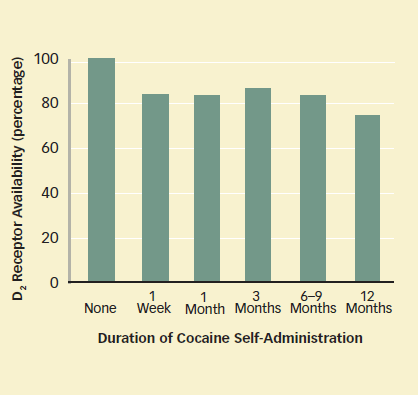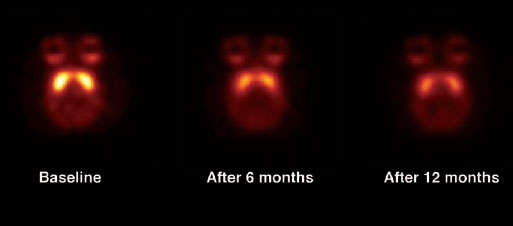In a study with rhesus monkeys, Dr. Michael Nader and colleagues at Wake Forest University recently showed that cocaine lowers availability of the dopamine D2 receptors in the basal ganglia—the brain region that includes key components of the reward system. The consequences may include addiction-promoting alterations in cognitive functioning and decisionmaking.
Dr. Nader's study also confirms previous findings that individual animals with lower D2 receptor availability are especially responsive to cocaine's reinforcing effects.
In a promising finding for people trying to recover from cocaine addiction, receptor availability levels in some of the monkeys recovered after less than a year of abstaining from drug use.
Receptor Availability and Cocaine Exposure
The D2 receptor resides in the outer membrane of brain cells that shape motivation and emotion, thought, and movement. The receptor protein enables the neurotransmitter dopamine to attach to these cells and affect their activity. At any given time, dopamine molecules occupy some of the D2 receptors, while the rest of the receptors remain available until a stimulus—such as drug exposure—increases dopamine levels. One hypothesis holds that the proportion of D2 receptors a person has free affects how strongly he or she responds to the stimulus.
 Cocaine Reduces Availability of D2 Receptors
Cocaine Reduces Availability of D2 ReceptorsImaging studies of the human brain have found reduced levels of available D2 receptors among abusers of cocaine. But that work could not distinguish between pre-existing differences in the proportion of available receptors and changes induced by drug use. The human studies also showed reduced availability of D2 receptors among abusers of heroin, nicotine, amphetamine, and alcohol. Lower D2 receptor availability has also been observed in other populations, such as the severely obese. So, findings on D2 receptor availability may be relevant to a wide range of addictions and conditions.
To measure monkeys' D2 receptor availability before cocaine exposure, Dr. Nader and colleagues injected each animal with a radiotracer that binds to the receptors. The radiotracer competes with dopamine for the receptor and provides a measure of D2 function. Over the course of a 3-hour brain imaging study, the scientists used positron emission tomography (PET) to visualize and quantify the bound radiotracer.
Next, the researchers allowed the monkeys to self-administer cocaine. Every day, they placed each monkey in an experimental chamber equipped with two levers—one that delivered banana pellets during the first 20 minutes of the test and another that provided the animal with an infusion of cocaine during the next 60 minutes. Then, the researchers put the animals through this sequence a second time. To describe the neurobiological effects of chronic cocaine exposure, the investigators continued the self-administration experiments and measured D2 receptor availability for a year.
The monkeys whose PET scans had revealed lower D2 receptor availability at baseline testing before their initial cocaine exposure self-administered cocaine at higher rates. This finding suggests that lower D2 receptor availability increases sensitivity to cocaine reward. Similar findings have been reported in studies that compared drug abusers and people who do not abuse drugs. The results also complement those of a prior study by Dr. Nader, which showed that subordinate monkeys, having lower D2 receptor availability, self-administered more cocaine than dominant monkeys, which have higher D2 receptor availability.
"This result, as well as findings of other studies, indicates that low D2 receptor availability corresponds to increased vulnerability to cocaine abuse," says Dr. Nader. "Perhaps an individual with low availability gets a greater kick from cocaine because the drug-induced dopamine release stimulates a greater percentage of their receptors. Another possibility is that the drug prompts some individuals' brain cells to release dopamine in particularly high quantities that are sufficient to fill the great majority of vacant D2 receptors, and this augments the high."
Variable Recovery
PET scans obtained at intervals throughout the trial revealed a rapid and marked suppressive effect of cocaine on D2 receptors. After 5 days of self-administration, the monkeys' available receptors had dropped by 15 percent, on average. This effect was reversible: In three monkeys that were allowed to self-administer the drug for 1 week, D2 receptor availability returned to baseline values by the third week of abstinence.
 Brain Scans: Dopamine 2 receptor availability (yellow) in the basal ganglia falls dramatically after 6 and 12 months of cocaine self-administration.
Brain Scans: Dopamine 2 receptor availability (yellow) in the basal ganglia falls dramatically after 6 and 12 months of cocaine self-administration.The picture was more complex, however, in five monkeys that self-administered cocaine for a year. At that time, D2 receptor availability was down 22 percent (see graph above). When access to cocaine was then stopped, three of the monkeys showed strong recovery—93 percent, on average—of receptor availability a month after cocaine cessation. But two monkeys had recovered only 80 percent and did not recover further over 12 months of abstinence.
Food Versus Drug
The researchers parsed the implications of the relationships between cocaine and D2 receptors by comparing the monkeys' patterns of lever pressing for the drug and for food. In contrast to the cocaine self-administration results, there was no correlation between D2 receptor availability and how often monkeys pressed the food lever. This suggests that low D2 receptor availability disposes individuals to seek the cocaine experience specifically, rather than rewarding experiences in general.
A clue to why recovery is more difficult for some individuals than others may come from the two monkeys whose D2 receptor availability failed to recover completely following year-long cocaine self-administration. Throughout the year of cocaine self-administration, these animals exhibited a reduced attraction to food, Dr. Nader says. When given the opportunity to press a lever for banana pellets, these animals did so only half as often as the monkeys whose receptors returned to baseline after long-term cocaine self-administration. "Although the findings are preliminary, we believe that these individuals may find rewards other than cocaine devalued," Nader says. "If it is not cocaine, it is just not rewarding to them." That trait may presage an unusually long-lasting influence of the drug.
Toward Treatment
"Predisposition seems to play a role in addiction, as does the dopamine system's rapid and robust reduction in D2 receptor availability in response to cocaine," says Dr. Nader.
The team's findings and those of others suggest that therapies that elevate D2 receptor availability may help prevent and treat cocaine abuse. According to Dr. Nader, the medications that appear most likely to accomplish this without deleterious side effects do so indirectly by altering neurotransmitters other than dopamine—either by increasing serotonin or gamma aminobutyric acid. Dr. Nader and his colleagues plan to test this strategy in monkeys.
In prior research, Dr. Nader has shown that enriching individuals' environments also can prompt the brain to generate additional D2 receptors. "My colleagues and I are most intrigued by an environmental enrichment strategy for increasing D2 receptor levels," Dr. Nader says. "This approach is based on the most profound result that my colleagues and I have ever observed: Adult monkeys that have a high level of control over the social environment show enhanced D2 receptor availability and markedly diminished response to cocaine's rewarding effects" (see "Social Environment Appears Linked to Biological Changes in Dopamine System, May Influence Vulnerability to Cocaine Addiction").
Other researchers have reported that, in rodents, environmental enrichment reverses the rewarding effects of cocaine. Dr. Nader and his team are preparing to test whether enhancing monkeys' environments—for example, by reducing stress, providing novel objects, and increasing peer interaction—can increase receptor availability and curb cocaine self-administration.
If the enrichment is successful, analogous provisions for people—improved living conditions, broad recreational choices, stress management techniques, and rewarding activities—might reduce vulnerability to cocaine abuse.
"A question for further research is whether animals whose D2 receptor availability levels remain low during abstinence are more likely to exhibit behaviors akin to relapse, compared with those whose receptors recover," says Dr. Cora Lee Wetherington of NIDA's Division of Basic Neuroscience and Behavioral Research. Dr. Nader says his team plans to adapt its current experimental protocol to explore this question in rhesus monkeys.
Sources
Nader, M.A., et al. Positron emission tomography imaging studies of dopamine receptors in primate models of addiction. Philosophical Transactions of the Royal Society of London, Series B 363 (1507):3223-3232, 2008. [Abstract]
Nader, M.A., and Czoty, P.W. Brain imaging in nonhuman primates: Insights into drug addiction. Institute for Laboratory Animal Research Journal 49(1):89-102, 2008. [Abstract]
Nader, M.A., et al. PET imaging of dopamine D2 receptors during chronic cocaine self-administration in monkeys. Nature Neuroscience 9(8):1050-1056, 2006. [Abstract]